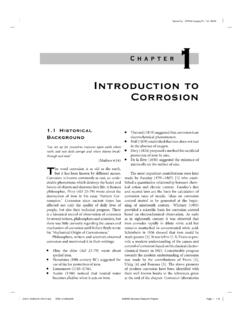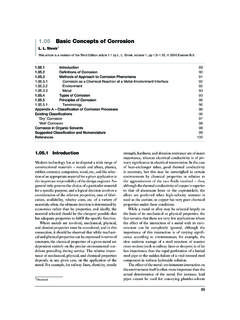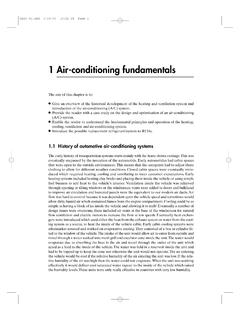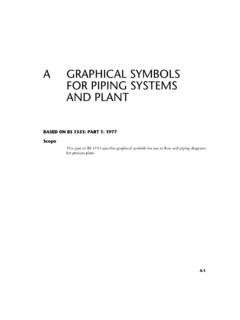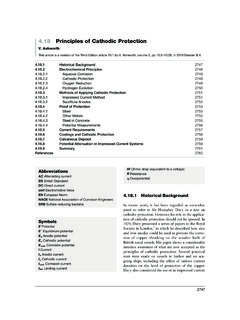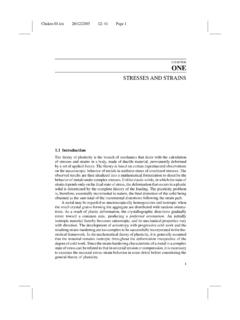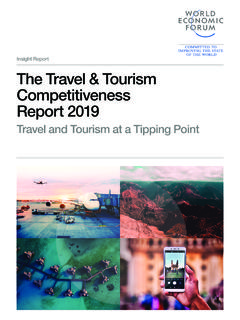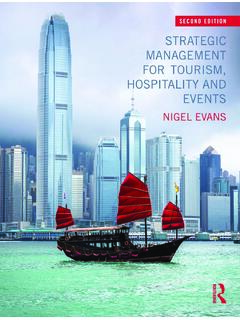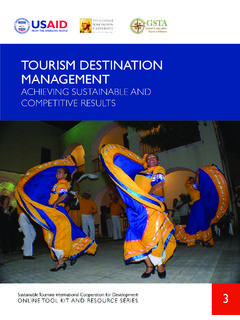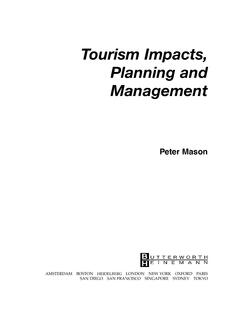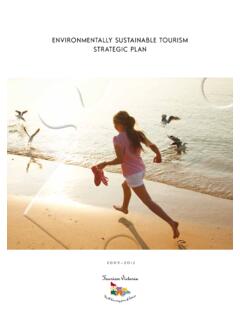Transcription of Tourism Growth, Development and Impacts
1 Part One Tourism Growth, Development and Impacts part 1 2/25/2008 3:27:12 PM. part 2 2/25/2008 3:27:12 PM. Chapter 1. Social change and the growth of Tourism Learning objectives At the end of this chapter you should: be aware of a variety of definitions of Tourism ;. be aware of a number of dimensions and components of Tourism , viz. the components of the Tourism industry, motivations for Tourism , Tourism systems, data limitations in Tourism ;. understand major social and economic changes that have contributed to the growth of Tourism . 3. 3 2/25/2008 1:58:07 PM. 4 T O U R I S M I M PA C T S , P L A N N I N G A N D M A N A G E M E N T. Introduction Tourism is now a global industry involving hundreds of millions of people in international as well as domestic travel each year.
2 The World Tourism Organization estimated (WTO, 2007) that there were 842 million international travellers in 2006 (this amounts to almost 12 per cent of the world's population). Although some of this activity may comprise the same travellers involved in more than one journey per year and hence the precise scale of Tourism as an industry is in some doubt (Leiper, 1999); tens of millions of people globally work directly in the industry and many more are employed indirectly. Hundreds of millions of people are on the receiving end of Tourism activity as they live in what are termed destination areas, in supposed host' populations. Millions of dollars are spent each year on advertising and promoting holidays and Tourism products.
3 For much of recorded history, travel was difficult, uncomfortable, expen- sive and frequently dangerous (Williams, 1998). Yet journeys were undertaken and this implies some strong motivating factors. However, it is only in the last 150 years, as travel has become more affordable and less difficult, that some of those who travelled were prepared to openly admit that pleasure was one of the motivations for their journeys. As recently as the 1960s, Tourism was an activity in which relatively few par- ticipated regularly, and was primarily confined to Europe, North America and a small number of locations in other parts of the world. International travel, prior to the 1960s, was still largely the preserve of a wealthy minority who had the time as well as money to afford long distance sea or air travel.
4 Major changes in the second half of the twentieth century led to the rapid and massive growth of the phenomenon known as modern Tourism . For example, these changes contributed to the Pacific Region/East Asia becoming the fastest growing area for international Tourism in the last 30 years. In 1975, East Asia and the Pacific Region accounted for only 4 per cent of international tourist arrivals, but by 1995 the share of world arrivals had increased to almost 15 per cent (Pearce, 1995) and by 2006 to 20 per cent (WTO, 2007). It should be noted that this change has occurred at a time when tourist numbers were growing globally. The increase in the share of international tourist arrivals in the Pacific Region therefore indicates a very significant increase in actual tourists between 1975 and 2006.
5 There were approximately 78 million vis- itor arrivals in the Pacific Region/East Asia in 1995 (Pearce, 1995). This compares with approximately 100 million in the combined area of North and South America 4 2/25/2008 1:58:07 PM. SOCIAL CHANGE AND THE GROWTH OF Tourism 5. and 305 million in Europe in 1995 (Pearce, 1995). With approximately 55 per cent of international arrivals Europe remained, in the early part of twenty-first century, the single most important region for international travel arrivals (WTO, 2007). In fact, Europe had five countries in the top ten Tourism destinations in 2006 France, Spain, Italy, the United Kingdom and Germany, with France and Spain's combined totals accounting for 14 per cent of total international arrivals (WTO, 2007).
6 This introductory chapter considers what has made this growth possible. It involves discussion of a number of economic and social factors. This chapter also explores changing attitudes to travel, as well as presenting a discussion of how opportunities for travel have increased. Key perspectives Definitions of Tourism and tourists This book is an introductory text to Tourism planning and management at undergraduate level, however, some understanding of the nature of Tourism is assumed. Nevertheless, as there is no full agreement on the meaning of the term Tourism , nor is there complete agreement on what a tourist is, this section con- tains a brief discussion of these concepts as they are clearly important in relation to the planning and management of Tourism .
7 In the early 1980s, Matthieson and Wall (1982, p. 1) indicated that Tourism comprised: The temporary movement of people to destinations outside their normal places of work and residence, the activities undertaken during the stay in those destinations , and the facilities created to cater for their needs. In 1991, the WTO created a definition, primarily to assist those whose respon- sibility it was to compile statistics in Tourism . This definition reads as follows: The activities of a person travelling outside his or her usual environment for less than a specified period of time whose main purpose of travel is other than for exercise of an activity remunerated from the place visited. (WTO, 1991). 5 2/25/2008 1:58:07 PM. 6 T O U R I S M I M PA C T S , P L A N N I N G A N D M A N A G E M E N T.
8 Neither of these two definitions makes reference to the Impacts of Tourism . Impacts are key factors to any discussion of the planning and management of Tourism . However, Jafari (1981) did include reference to Impacts in his definition. Jafari (1981, p. 3) stated: Tourism is a study of man (sic) away from his usual habitat, of the industry which responds to his needs and the Impacts that both he and the industry have for the host socio-cultural, economic and physical environments. Most definitions of the term tourist are based on the concept of Tourism . Usually, such definitions make reference to the need for the tourist to spend at least one night in a destination to which he or she has travelled. Tourists can be distinguished from excursionists in such definitions, as an excursionist is some- one who visits and leaves without staying a night in a destination (Prosser, 1998).
9 However, as Prosser suggested, it is relatively common today for the two terms to be combined. The term visitor is often used in preference to either tourist or excursionist. Theobold (1994), for example, used the concept of visitor ' to combine the elements of a tourists and excursionist. When discussing the Impacts of Tourism , a classification involving terms such as excursionist or tourist is not particularly helpful. For example, in relation to the environmental Impacts of the feet of a walker on a natural or semi-natural landscape, it matters little whether the person involved is classified as a tourist or an excursionist; the feet will have the same effect! As the actions of day visitors (excursionists) and those of longer stayers may be almost indistinguishable, the view that a definition of Tourism does not need reference to an overnight stay has been become far more acceptable recently (Williams, 1998).
10 The distance travelled is often seen as important in definitions of both tour- ism and tourists. However, there is no commonly accepted international dis- tance used in connection with definitions of Tourism . As with the need of at least some definitions to include reference to an overnight stay, there is a good deal of debate and unresolved confusion about distance travelled and Tourism def- initions. In the United States, for example, the US Travel Data Centre reports on all trips with a one-way distance of 100 miles, the Canadian Travel Survey uses a lower than one-way limit of 50 miles, and the Australian Bureau of Industry Economics employs a one-way distance of 25 miles (Prosser, 1998). 6 2/25/2008 1:58:07 PM. SOCIAL CHANGE AND THE GROWTH OF Tourism 7.
